Effects of Reinforcement Volume Fraction on Mechanical Properties and Microstructures of 7075Al Matrix Composites Reinforced by FeCoCrNiAl High-Entropy Alloy Particles
Abstract
:1. Introduction
2. Experimental
2.1. Fabrication of HEAp/Al Composites
2.2. Testing and Characterization
3. Results and Discussion
3.1. X-ray Diffraction Patterns of HEAp/Al Composites
3.2. Microstructure of HEAp/Al Composites
3.3. Interface Microstructure of HEAp/Al Composites
3.4. Hardness of HEAp/Al Composites
3.5. Mechanical Properties and Failure of HEAp/Al Composites
4. Conclusions
- FeCoCrNiAl high-entropy alloy particles (HEAp) reinforced 7075Al matrix composites (HEAp/Al) with dense microstructure and homogeneous distribution of reinforcement were fabricated by vacuum hot pressing sintering process at 580 °C, 30 MPa with 10 min holding time;
- With the increase of HEAp volume fractions, the hardness of HEAp/Al composites increase and have a larger value compared with the 7075Al matrix. While flexural strength and fracture toughness of HEAp/Al composites increase first and then decrease. the HEAp/Al composites with HEAp volume fraction of 10 vol% show the highest maximum value of ~640 MPa and ~13.67 MPa·m1/2 and temperate density with the value of 3.19 g/cm3, respectively. The strengthening effect including load transfer effect and dislocation strengthening behavior increased with the improvement of HEAp content from 5 vol% to 15 vol%, while it was weakened when HEAp was up to 20 vol%.
Author Contributions
Funding
Institutional Review Board Statement
Informed Consent Statement
Data Availability Statement
Conflicts of Interest
References
- Srinivasan, V.; Kunjiappan, S.; Palanisamy, P. A brief review of carbon nanotube reinforced metal matrix composites for aerospace and defense applications. Int. Nano Lett. 2021, 11, 321–345. [Google Scholar] [CrossRef]
- Chen, L.; Zhao, M.; Wang, Z. Production and application of aluminum matrix composites in Chinese civil aircraft. Light Alloys Fabr. Technol. 2020, 48, 1–7. [Google Scholar]
- Liao, H.L.; Zhu, H.H.; Xue, G.; Zeng, X.Y. Alumina loss mechanism of Al2O3-AlSi10Mg composites during selective laser melting. J. Alloys Compd. 2019, 785, 286–295. [Google Scholar] [CrossRef]
- Yuan, G.Q.; Zhang, J.L.; Li, K.Z.; Xie, H.B.; Li, F.L.; Zhang, H.J. Mechanical properties and friction characteristic of selective laser melting-fabricated (SiCp-B4Cp)/Al composites. J. Chin. Ceram. Soc. 2021, 49, 2563–2571. [Google Scholar]
- Kannan, C.; Ramanujam, R.; Balan, A.S.S. Machinability studies on Al 7075/BN/Al2O3 squeeze cast hybrid nanocomposite under different machining environments. Mater. Manuf. Processes 2018, 33, 587–595. [Google Scholar] [CrossRef]
- Li, W.D.; Xie, D.; Li, D.Y.; Zhang, Y.; Gao, Y.F.; Liaw Peter, K. Mechanical behavior of high-entropy alloys. Prog. Mater. Sci. 2021, 118, 100777. [Google Scholar] [CrossRef]
- Alaneme, K.K.; Bodunrin, M.O.; Oke, S.R. Processing, alloy composition and phase transition effect on the mechanical and corrosion properties of high entropy alloys: A review. J. Mater. Res. Technol. 2016, 5, 384–393. [Google Scholar] [CrossRef] [Green Version]
- Wu, S.Y.; Qiao, D.X.; Zhang, H.T.; Miao, J.W.; Zhao, H.L.; Wang, J.; Lu, Y.P.; Wang, T.M.; Li, T.J. Microstructure and mechanical properties of CxHf0.25NbTaW0.5 refractory high-entropy alloys at room and high temperatures. J. Mater. Sci. Technol. 2022, 97, 229–238. [Google Scholar] [CrossRef]
- Anand Sekhar, R.; Shifin, A.S.; Firoz, N. Microstructure and mechanical properties of AlCoCrNiTi–C High Entropy Alloy processed through Spark Plasma Sintering. Mater. Chem. Phys. 2021, 270, 124846. [Google Scholar] [CrossRef]
- Wang, P.; Qi, J.F.; Chen, Z.W.; Lao, C.S.; Scudino, S. Microstructure and mechanical properties of novel high-entropy alloy particle reinforced aluminum matrix composites fabricated by selective laser melting. J. Alloys Compd. 2021, 868, 159197. [Google Scholar] [CrossRef]
- Zhao, B.; Zhu, D.Z.; Wen, D.B.; Zhan, Q.Q.; Chen, L. Effect of reinforcement morphology on microstructure and properties of high-entropy alloy particles reinforced cast aluminum alloy. Rare Met. Mater. Eng. 2019, 48, 4004–4009. [Google Scholar]
- Yuan, Z.W.; Tian, W.B.; Li, F.G.; Fu, Q.Q.; Wang, X.G.; Qian, W.F.; An, W.C. Effect of heat treatment on the interface of high-entropy alloy particles reinforced aluminum matrix composites. Alloy. Compd. 2020, 822, 153658. [Google Scholar] [CrossRef]
- Wang, Z.W.; Yuan, Y.B.; Zheng, R.X.; Ameyama, K.; Ma, C.L. Microstructures and mechanical properties of extruded 2024 aluminum alloy reinforced by FeNiCrCoAl3 particles. Trans. Nonferrous Met. Soc. China 2014, 24, 2366–2373. [Google Scholar] [CrossRef]
- Karthik, M.G.; Panikar, S.; Janaki, G.D.; Kottada Sankar, R. Additive manufacturing of an aluminum matrixcomposite reinforced with nanocrystalline high entropy alloy particles. Mater. Sci. Eng. A 2017, 679, 193–203. [Google Scholar] [CrossRef]
- Gao, J.; Wang, X.; Zhang, S.; Yu, L.; Shen, Y. Producing of FeCoNiCrAl high-entropy alloy reinforced Al composites via friction stir processing technology. Int. J. Adv. Manuf. Technol. 2020, 110, 569–580. [Google Scholar] [CrossRef]
- Soorya Prakash, K.; Purusothaman, M.; Sasikumar, M. Fabrication and characterization of metal-high entropy alloy composites. Inter. Met. 2020, 14, 547–555. [Google Scholar] [CrossRef]
- Zhu, D.Z.; Qi, L.F.; Ding, X. Effects of volume fraction and sintering temperature on coefficient of thermal expansion of (AlSiTiCrNiCu)p/6061Al composites. Trans. Nonferrous Met. Soc. China 2018, 28, 1284–1290. [Google Scholar]
- Pozdniakov, A.V.; Lotfy, A.; Qadir, A.; Shalaby, E.; Khomutov, M.G.; Churyumov, A.Y.; Pozdniakov, A.V.; Zolotorevskiy, V.S. Development of Al-5Cu/B4C composites with low coefficient of thermal expansion for automotive application. Mater. Sci. Eng. A 2017, 688, 1–8. [Google Scholar] [CrossRef]
- Wang, Z.H. Characteristics of silicon carbide particle reinforced aluminum alloy composites. Trans. Nonferrous Met. Soc. China 1995, 5, 123–125. [Google Scholar]
- Wang, W.R.; Wang, W.L.; Wang, S.C.; Tsai, Y.C.; Lai, C.H.; Yeh, J.W. Effects of Al addition on the microstructure and mechanical property of AlxCoCrFeNi high-entropy alloys. Intermetallics 2012, 26, 44–51. [Google Scholar] [CrossRef]
- Zhang, Y.; Zuo, T.T.; Tang, Z.; Gao, M.C.; Dahmene, K.A.; Liaw, P.K.; Lu, Z.P. Microstructures and properties of high-entropy alloys. Prog. Mater. Sci. 2014, 61, 1–93. [Google Scholar] [CrossRef]
- Zhu, J.M.; Fu, H.M.; Zhang, H.F.; Wang, A.M.; Li, H.; Hu, Z.Q. Microstructures and compressive properties of multicomponent AlCoCrFeNiMox alloys. Mater. Sci. Eng. A 2010, 527, 6975–6979. [Google Scholar] [CrossRef]
- Liu, W.H.; Wu, Y.; He, J.Y.; Zhang, Y.; Liu, C.T.; Lu, Z.P. The phase competition and stability of high-entropy alloys. JOM 2014, 66, 1973–1983. [Google Scholar] [CrossRef]
- Veronesi, P.; Colombini, E.; Rosa, R.; Leonelli, C.; Garuti, M. Microwave processing of high entropy alloys: A powder metallurgy approach. Chem. Eng. Process. 2017, 122, 397–403. [Google Scholar] [CrossRef] [Green Version]
- Takeuchi, A.; Inoue, A. Classification of bulk metallic glasses by atomic size difference, heat of mixing and period of constituent elements and its application to characterization of the main alloying element. Mater. Trans. 2005, 46, 2817–2829. [Google Scholar] [CrossRef] [Green Version]
- Wang, Z.W.; Song, M.; Sun, C.; Xiao, D.H.; He, Y.H. Effect of extrusion and particle volume fraction on the mechanical properties of SiC reinforced Al–Cu alloy composites. Mater. Sci. Eng. A 2010, 527, 6537–6542. [Google Scholar] [CrossRef]
- Dai, L.H.; Ling, Z.; Bai, Y.L. Size-dependent inelastic behavior of particle-reinforced metal-matrix composites. Compos. Sci. Technol. 2001, 61, 1057–1063. [Google Scholar] [CrossRef]
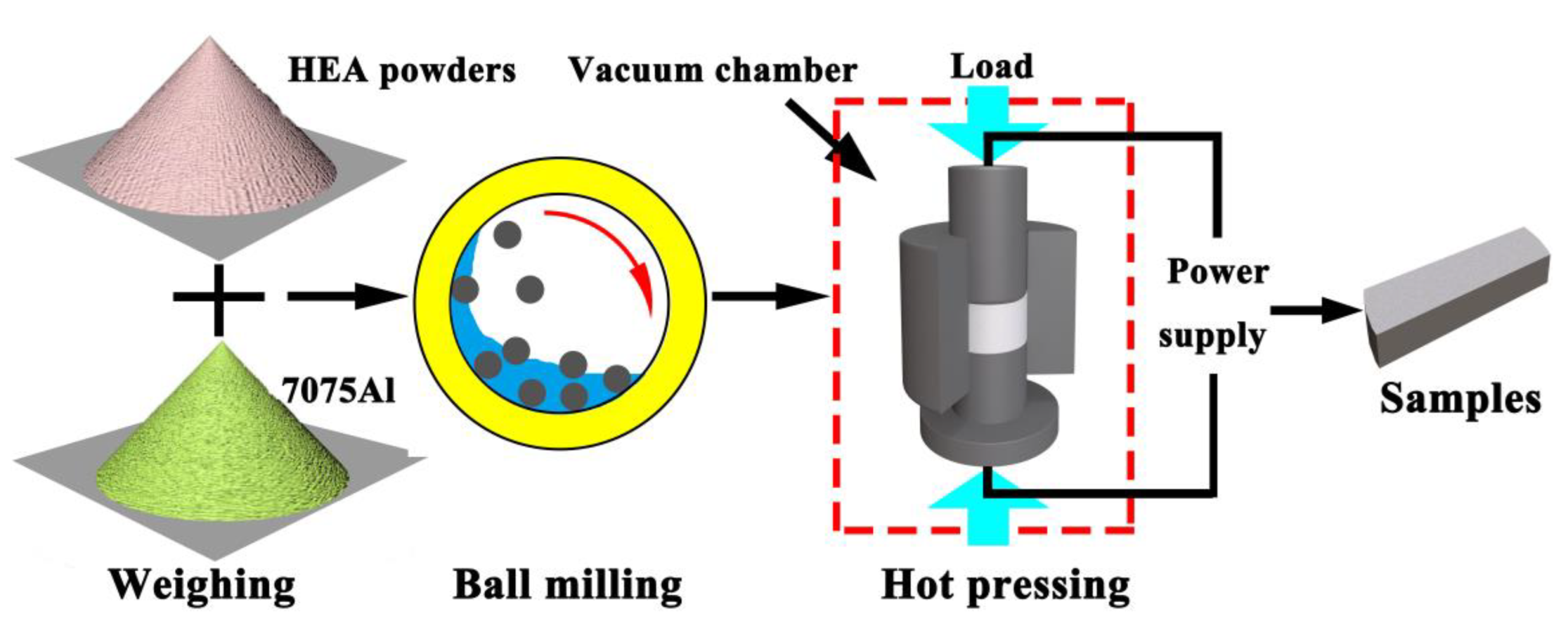

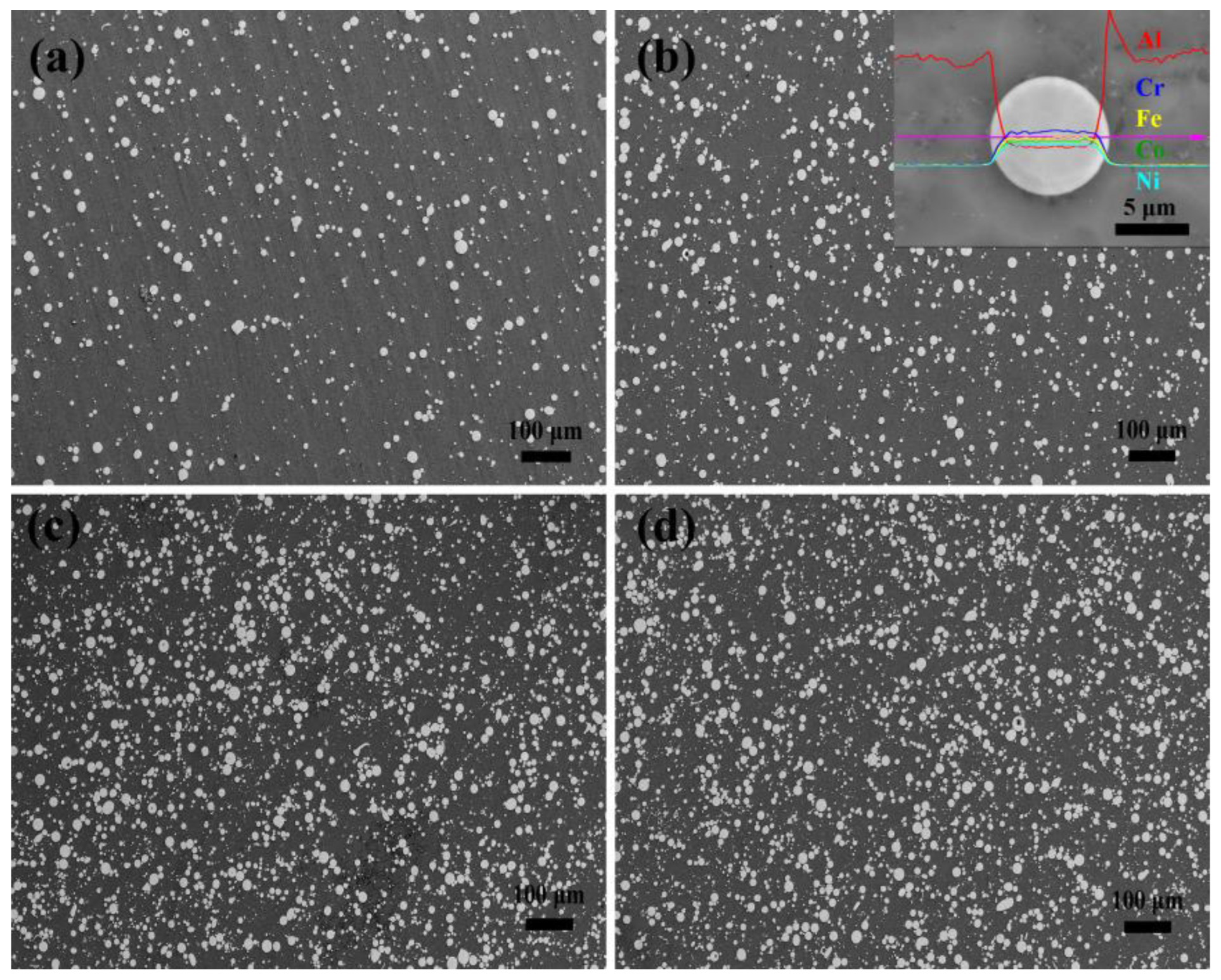

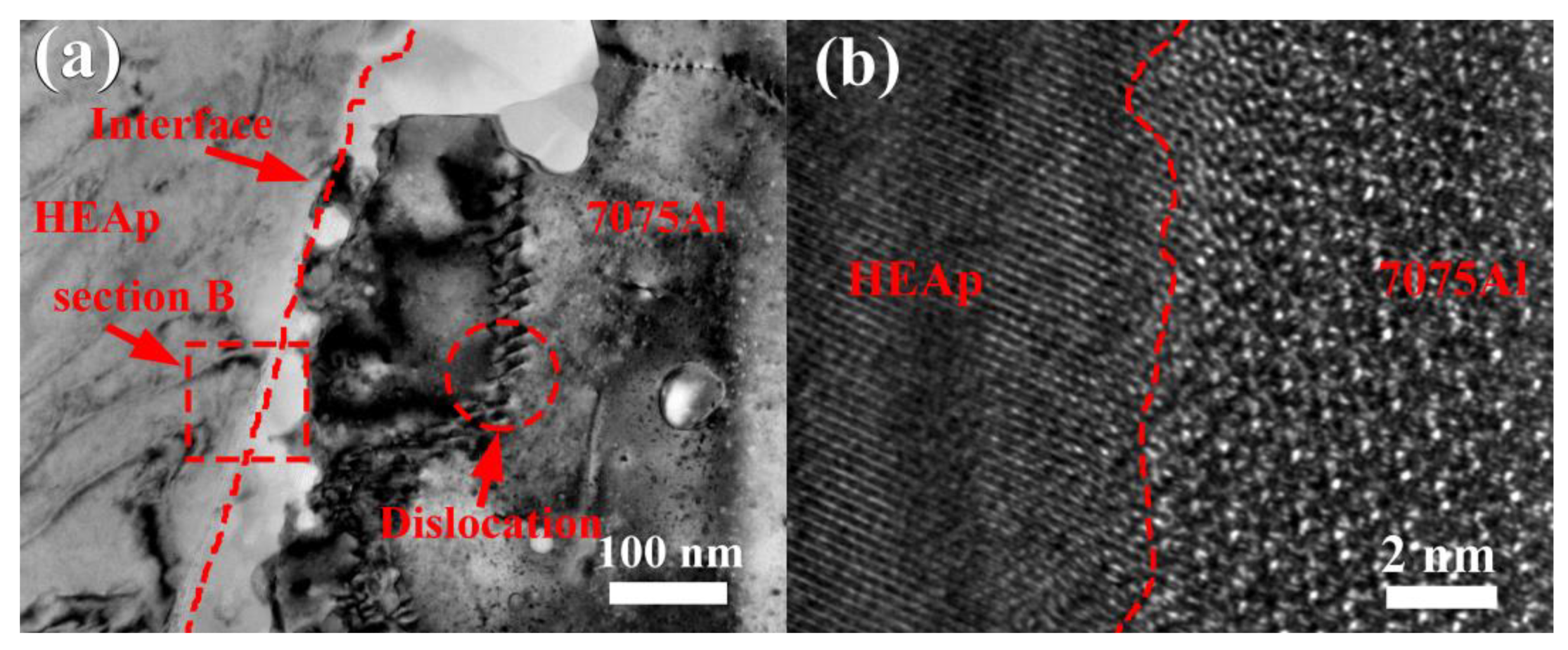
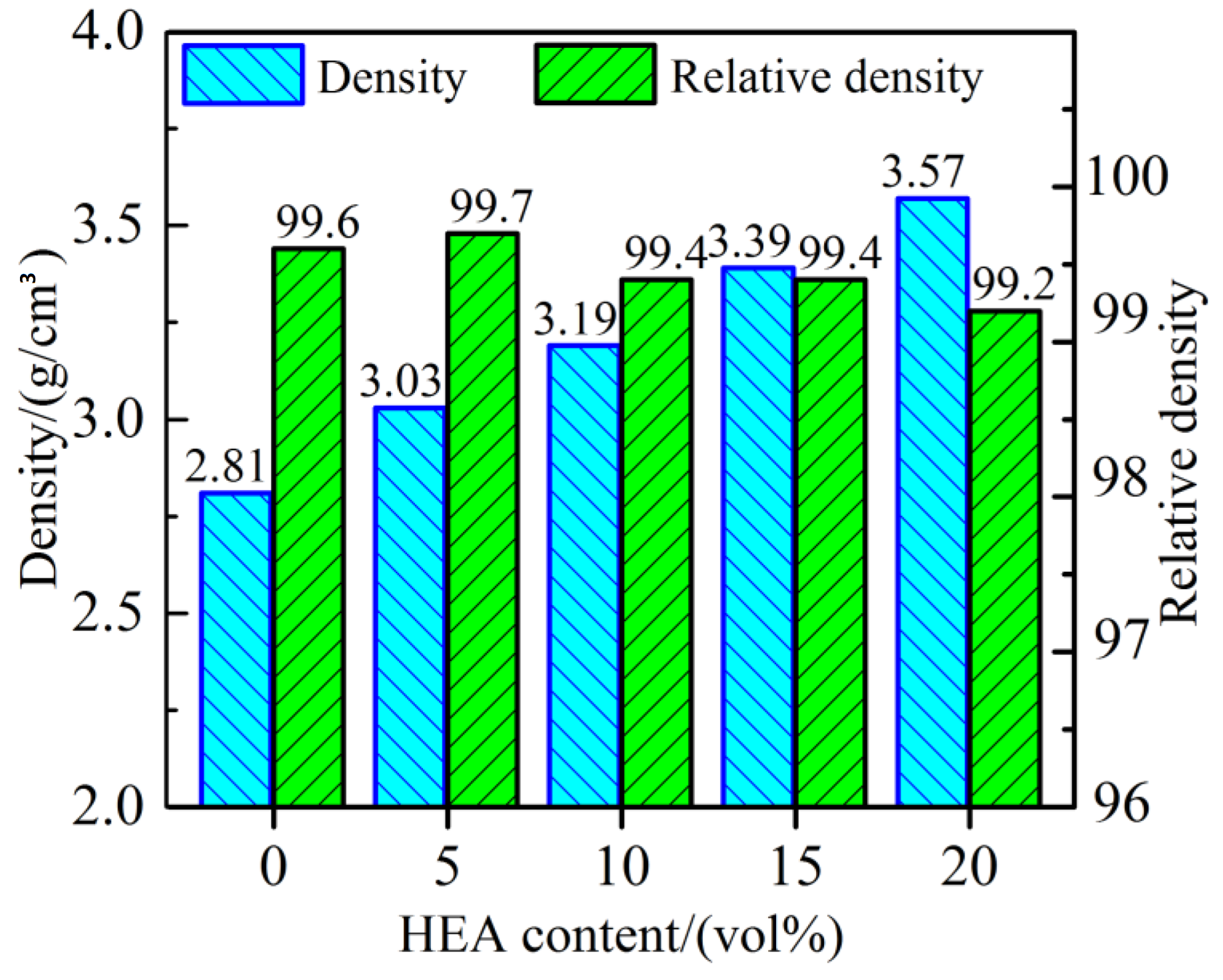


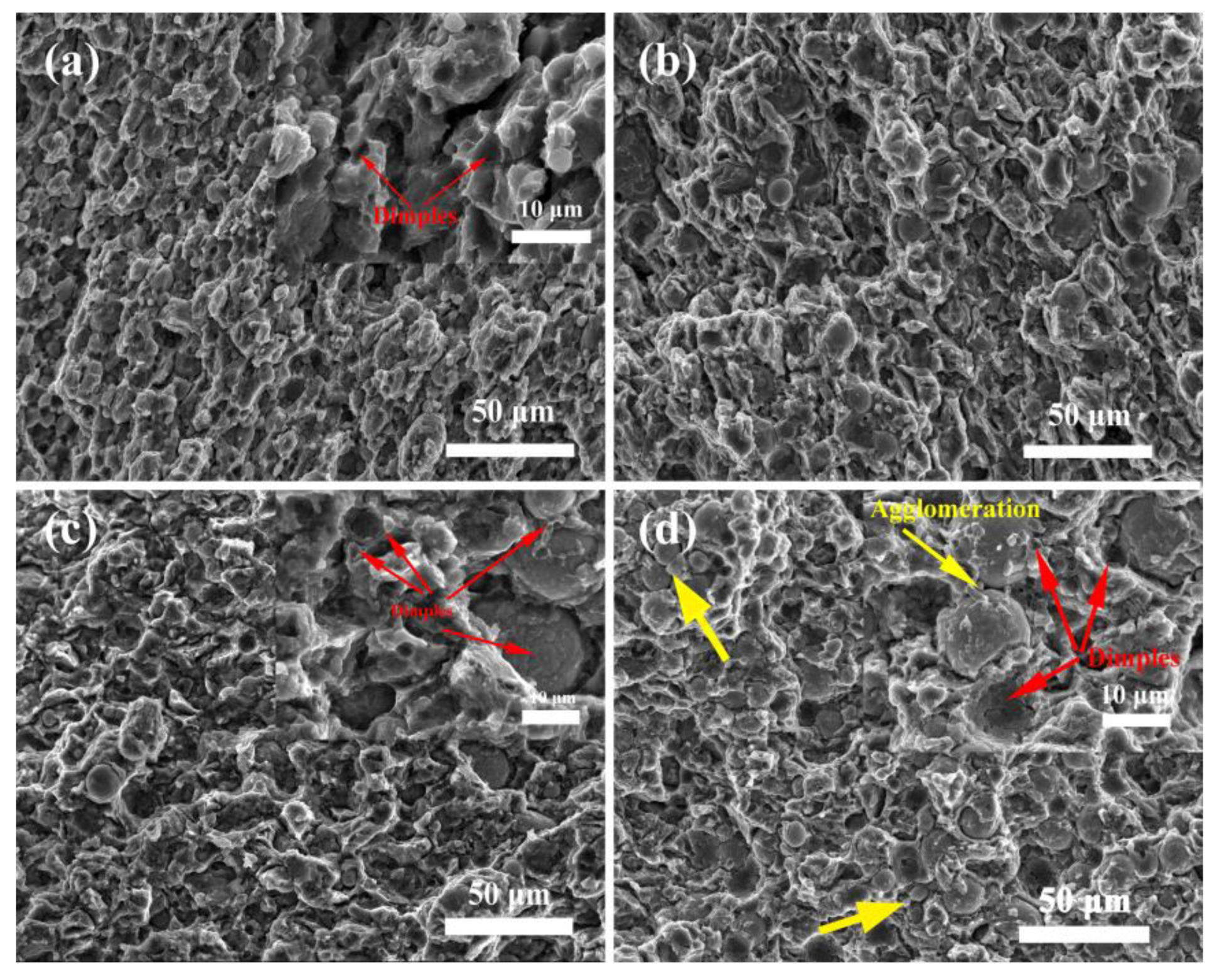
Publisher’s Note: MDPI stays neutral with regard to jurisdictional claims in published maps and institutional affiliations. |
© 2022 by the authors. Licensee MDPI, Basel, Switzerland. This article is an open access article distributed under the terms and conditions of the Creative Commons Attribution (CC BY) license (https://creativecommons.org/licenses/by/4.0/).
Share and Cite
Gao, C.; Wang, Q.; Wei, M.; Fan, H.; Zhao, L.; Wei, Y.; Ma, Q. Effects of Reinforcement Volume Fraction on Mechanical Properties and Microstructures of 7075Al Matrix Composites Reinforced by FeCoCrNiAl High-Entropy Alloy Particles. Metals 2022, 12, 851. https://doi.org/10.3390/met12050851
Gao C, Wang Q, Wei M, Fan H, Zhao L, Wei Y, Ma Q. Effects of Reinforcement Volume Fraction on Mechanical Properties and Microstructures of 7075Al Matrix Composites Reinforced by FeCoCrNiAl High-Entropy Alloy Particles. Metals. 2022; 12(5):851. https://doi.org/10.3390/met12050851
Chicago/Turabian StyleGao, Changqi, Qiaobo Wang, Mingyu Wei, Hongjing Fan, Libo Zhao, Yupeng Wei, and Qin Ma. 2022. "Effects of Reinforcement Volume Fraction on Mechanical Properties and Microstructures of 7075Al Matrix Composites Reinforced by FeCoCrNiAl High-Entropy Alloy Particles" Metals 12, no. 5: 851. https://doi.org/10.3390/met12050851




